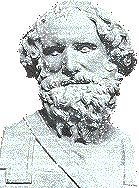Spiral (Grades K-4)
Introduction
 
This spiral was studied by Archimedes in about 225 BC in a work On Spirals. Although it had already been considered by his friend Conon, it is often called the Spiral of Archimedes. Archimedes was able to work out the lengths of various tangents to the spiral. Activity Making the Tool The tool used in this exercise is made from a 4 by 6 sq. in. index card with one inch marked on its short side. This tool is used to draw right triangles that have one leg which is one inch long. Task 1. Draw a spiral built from right triangles that have one leg 1 inch long. (See picture.) Start with a right triangle that has both legs 1 inch long. Using the tool, draw the next triangle, starting with the hypotenuse of the previous one. Stop before the triangles overlap.
Remark:
Compute the decimal equivalents in the table as follows: 1 13/16 is computed by
Remark: If students do not know the Pythagorean Theorem, this may be its first introduction. Lesson Index |